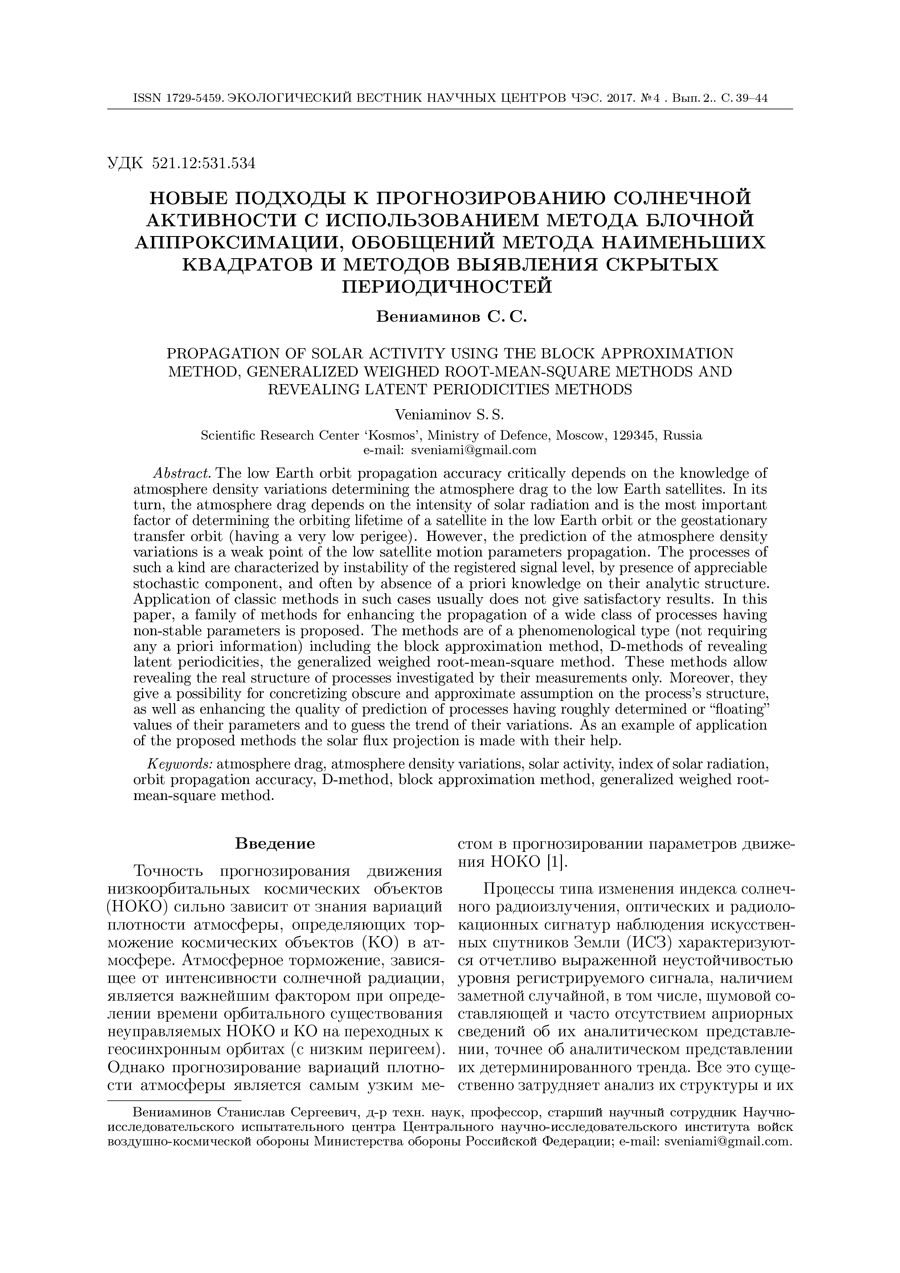Propagation of solar activity using the block approximation method, generalized weighed root-mean-square methods and revealing latent periodicities methods
UDC
521.12:531.534Abstract
The low Earth orbit propagation accuracy critically depends on the knowledge of atmosphere density variations determining the atmosphere drag to the low Earth satellites. In its turn, the atmosphere drag depends on the intensity of solar radiation and is the most important factor of determining the orbiting lifetime of a satellite in the low Earth orbit or the geostationary transfer orbit (having a very low perigee). However, the prediction of the atmosphere density variations is a weak point of the low satellite motion parameters propagation. The processes of such a kind are characterized by instability of the registered signal level, by presence of appreciable stochastic component, and often by absence of a priori knowledge on their analytic structure. Application of classic methods in such cases usually does not give satisfactory results. In this paper, a family of methods for enhancing the propagation of a wide class of processes having non-stable parameters is proposed. The methods are of a phenomenological type (not requiring any a priori information) including the block approximation method, D-methods of revealing latent periodicities, the generalized weighed root-mean-square method. These methods allow revealing the real structure of processes investigated by their measurements only. Moreover, they give a possibility for concretizing obscure and approximate assumption on the process’s structure, as well as enhancing the quality of prediction of processes having roughly determined or “floating” values of their parameters and to guess the trend of their variations. As an example of application of the proposed methods the solar flux projection is made with their help.
Keywords:
solar activity, forecasting accuracy, atmosphere density variations, block approximation method, generalized weighted least squares method, hidden frequency, D-methodsReferences
- Vavrin A.B. Solar cycle sensitivity study of breakup events in LEO. Orbital Debris Quarterly News, 2015, vol. 19, iss. 1, pp. 6-7.
- Veniaminov S.S. Revealing latent structural patterns in processes and signals. URSS Pub., Moscow, 2014, 216 p. (In Russian)
- Veniaminov S.S. Revealing latent structural patterns in processes and signals. URSS, Spain, 2014.
- Veniaminov S.S. The new family of methods for revealing latent periodicities in signals. Proc. of 2nd European Conference on Space Debris, ECA, Darmstadt, Germany, 1997.
- Veniaminov S.S., Dicky V.I., Tretyakov Yu.N. The New Approach to Revealing Latent Periodicities in Radar and Optical Sygnals. Proc. of 4th US/Russian Workshop on Space Surveillance, Washington D.C. 2000.
- Veniaminov S.S., Dicky V.I., Tretyakov Yu.N., Seidelmann P.K. Revealing latent periodicities in noisy signals. Proc. of 4th US/Russian Workshop on Space Surveillance, Washington D.C. 2000.
- Solar Flux Values, 2800 Mc. National Research Council, Ottawa, 1967.
Downloads
Issue
Pages
Submitted
Published
How to Cite
Copyright (c) 2017 Veniaminov S.S.

This work is licensed under a Creative Commons Attribution 4.0 International License.




